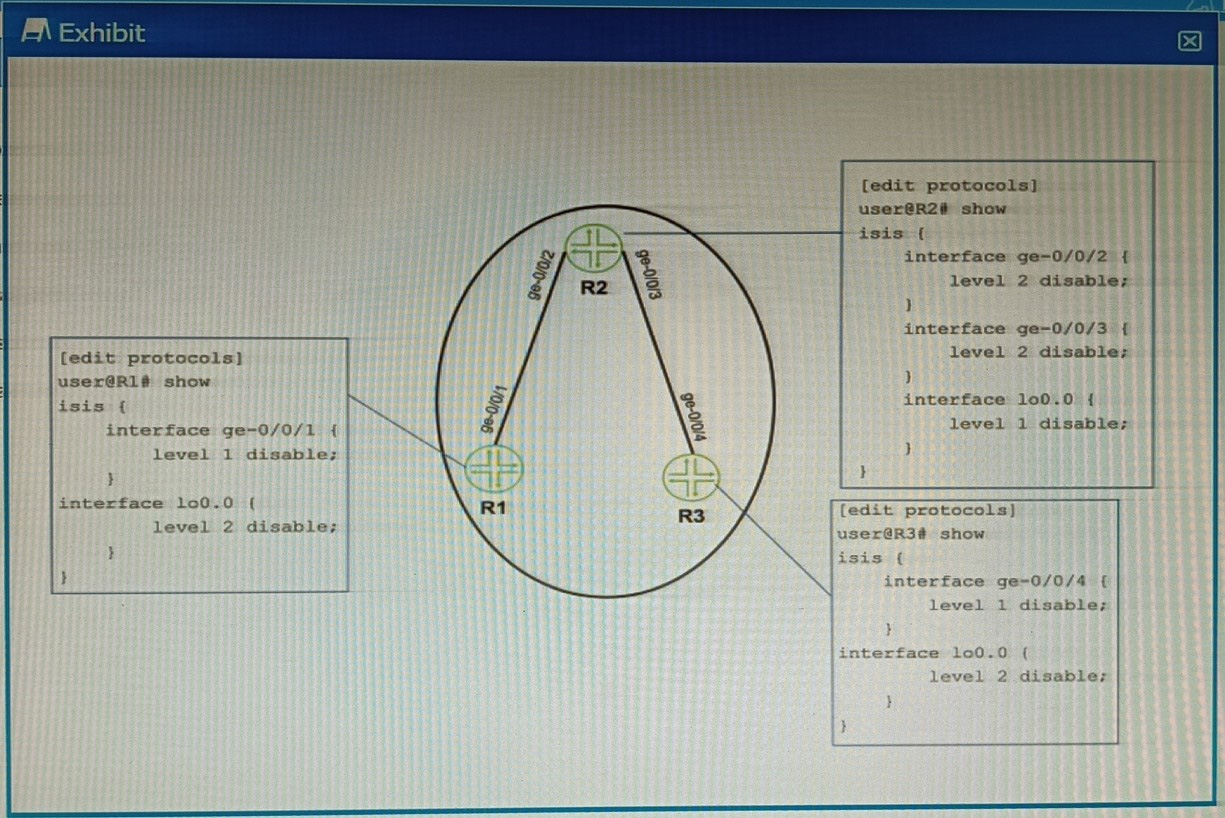Exam Details
Exam Code
:JN0-351Exam Name
:Enterprise Routing and Switching, Specialist (JNCIS-ENT)Certification
:Juniper CertificationsVendor
:JuniperTotal Questions
:175 Q&AsLast Updated
:Mar 28, 2025
Juniper Juniper Certifications JN0-351 Questions & Answers
-
Question 171:
You need to configure a LAG between your switches. In this scenario, which two statements are correct? (Choose two.)
A. Duplex and speed settings are not required to match on both participating devices.
B. Duplex and speed settings are required to match on both participating devices.
C. Member links are not required to be contiguous ports.
D. Member links are required to be contiguous ports.
-
Question 172:
Which statement about aggregate routes is correct?
A. Aggregate routes can only be used for static routing but not for dynamic routing protocols.
B. Aggregate routes are automatically generated for all of the subnets in a routing table.
C. Aggregate routes are always preferred over more specific routes, even when the specific routes have a better path.
D. Aggregate routes are used for advertising summarized network prefixes.
-
Question 173:
You are asked to create a new firewall filter to evaluate Layer 3 traffic that is being sent between VLANs. In this scenario, which two statements are correct? (Choose two.)
A. You should create a family Ethernet-switching firewall filter with the appropriate match criteria and actions.
B. You should apply the firewall filter to the appropriate VLAN.
C. You should create a family inet firewall filter with the appropriate match criteria and actions.
D. You should apply the firewall filter to the appropriate IRB interface.
-
Question 174:
Which two statements about BGP facilitate the prevention of routing loops between two autonomous systems? (Choose two.)
A. EBGP routers will append their AS number when advertising routes to their neighbors.
B. EBGP routers will only accept routes that contain their own AS number in the AS_PATH.
C. EBGP routers will drop routes that contain their own AS number in the AS_PATH
D. EBGP routers will prepend their AS number when advertising routes to their neighbors
-
Question 175:
Exhibit Referring to the exhibit, which two configuration changes must you apply for packets to reach from R1 to R3 using IS-IS? (Choose two.)

Explanation: A. On R1, enable Level 1 on the ge-0/0/1 interface. In IS-IS, both levels (Level 1 and Level 2) are enabled by default when you enable IS-IS on an interface1. Level 1 systems route within an area2. If the destination is outside an area, Level 1 systems route toward a Level 2 system2. Therefore, enabling Level 1 on the ge-0/0/1 interface on R1 would allow packets to reach from R1 to R3.
A. On R1, enable Level 1 on the ge-0/0/1 interface.
B. On R3 disable Level 2 on the ge-0/0/4 interface.
C. On R1, disable Level 2 on the ge-0/0/1 interface.
D. On R3 enable Level 1 on the ge-0/0/4 interface
Related Exams:
JN0-102
Internet Associate, Junos(JNCIA-Junos)JN0-104
Junos, Associate (JNCIA-Junos)JN0-105
Junos, Associate (JNCIA-Junos)JN0-1101
Juniper Networks Certified Design Associate (JNCDA)JN0-130
Juniper networks Certified internet specialist.e(jncis-e)JN0-1301
Data Center Design, Specialist (JNCDS-DC)JN0-1302
Data Center Design Specialist (JNCDS-DC)JN0-1331
Security Design, Specialist (JNCDS-SEC)JN0-1332
Security Design, Specialist (JNCDS-SEC)JN0-1361
Service Provider Design Specialist (JNCDS-SP)
Tips on How to Prepare for the Exams
Nowadays, the certification exams become more and more important and required by more and more enterprises when applying for a job. But how to prepare for the exam effectively? How to prepare for the exam in a short time with less efforts? How to get a ideal result and how to find the most reliable resources? Here on Vcedump.com, you will find all the answers. Vcedump.com provide not only Juniper exam questions, answers and explanations but also complete assistance on your exam preparation and certification application. If you are confused on your JN0-351 exam preparations and Juniper certification application, do not hesitate to visit our Vcedump.com to find your solutions here.